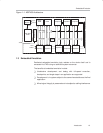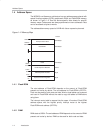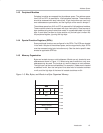
Architecture
1-2
Introduction
1.1 Architecture
The MSP430 incorporates a 16-bit RISC CPU, peripherals, and a flexible clock
system that interconnect using a von-Neumann common memory address
bus (MAB) and memory data bus (MDB). Partnering a modern CPU with
modular memory-mapped analog and digital peripherals, the MSP430 offers
solutions for demanding mixed-signal applications.
Key features of the MSP430x1xx family include:
- Ultralow-power architecture extends battery life
J 0.1-µA RAM retention
J 0.8-µA real-time clock mode
J 250-µA / MIPS active
- High-performance analog ideal for precision measurement
J 12-bit or 10-bit ADC — 200 ksps, temperature sensor, V
Ref
J
12-bit dual-DAC
J Comparator-gated timers for measuring resistive elements
J Supply voltage supervisor
- 16-bit RISC CPU enables new applications at a fraction of the code size.
J Large register file eliminates working file bottleneck
J Compact core design reduces power consumption and cost
J Optimized for modern high-level programming
J Only 27 core instructions and seven addressing modes
J Extensive vectored-interrupt capability
- In-system programmable Flash permits flexible code changes, field
upgrades and data logging
1.2 Flexible Clock System
The clock system is designed specifically for battery-powered applications. A
low-frequency auxiliary clock (ACLK) is driven directly from a common 32-kHz
watch crystal. The ACLK can be used for a background real-time clock self
wake-up function. An integrated high-speed digitally controlled oscillator
(DCO) can source the master clock (MCLK) used by the CPU and high-speed
peripherals. By design, the DCO is active and stable in less than 6 µs.
MSP430-based solutions effectively use the high-performance 16-bit RISC
CPU in very short bursts.
- Low-frequency auxiliary clock = Ultralow-power stand-by mode
- High-speed master clock = High performance signal processing


















